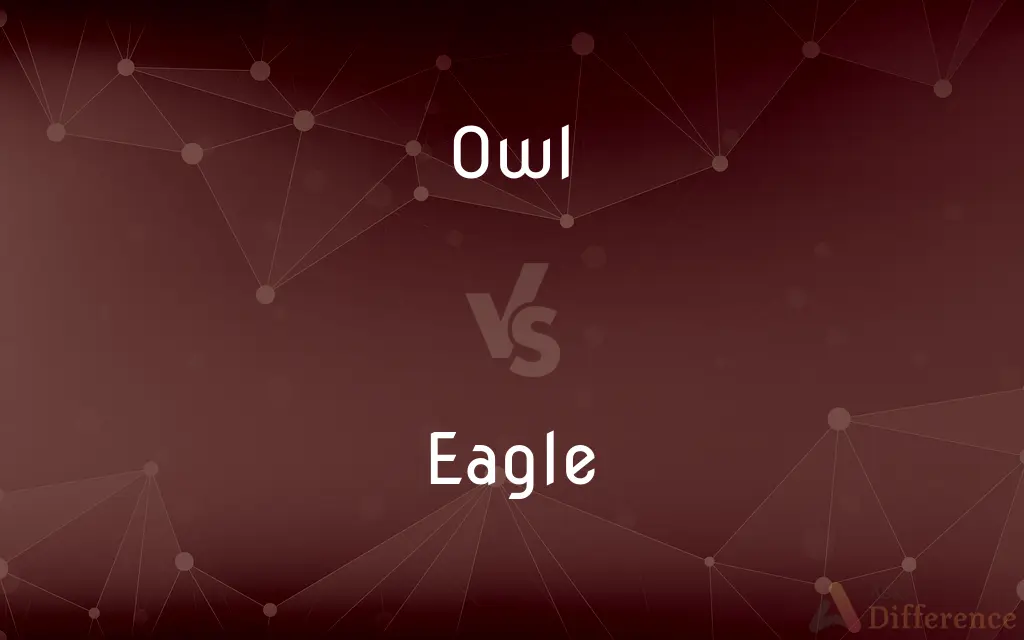Owl vs. Eagle — What's the Difference?
Edited by Tayyaba Rehman — By Fiza Rafique — Updated on March 7, 2024
Owls are nocturnal birds of prey known for silent flight and hunting at night, while eagles are diurnal, known for their powerful build and keen vision, hunting during the day.

Difference Between Owl and Eagle
Table of Contents
ADVERTISEMENT
Key Differences
Owls are characterized by their distinctive facial disks, which funnel sound to their ears, providing exceptional hearing. This adaptation, along with their silent flight, makes them adept nocturnal hunters, specializing in catching prey under the cover of darkness. In contrast, eagles are recognized for their size, strength, and sharp vision, allowing them to spot prey from great distances during the day. Eagles have a powerful build, with large, strong talons and beaks designed for hunting and consuming larger prey.
While owls typically inhabit a variety of environments, including forests, deserts, and urban areas, they are often solitary and elusive, blending into their surroundings. Eagles, however, are more commonly found near water bodies like lakes and rivers or open grasslands where they can easily spot and swoop down on their prey. Eagles are also known for their nest-building skills, constructing large nests in high places.
The diets of owls and eagles also reflect their different hunting strategies and times. Owls often feed on smaller mammals, insects, and other birds, capturing these creatures stealthily at night. Eagles, on the other hand, have a diet that can include fish, mammals, and birds, utilizing their speed and power to catch larger, more robust prey.
Owls communicate using a variety of sounds, including hoots, screeches, and whistles, with each species having its own distinctive calls used for territory establishment and mating signals. Eagles are less varied in their vocalizations but use calls to communicate over long distances, especially in mating rituals and territorial defense.
Conservation statuses vary among species for both owls and eagles. Some species of owls and eagles are considered endangered or at risk due to habitat destruction, pollution, and hunting. Conservation efforts are in place globally to protect these birds and their habitats, highlighting the importance of both to biodiversity and ecosystem health.
ADVERTISEMENT
Comparison Chart
Activity Time
Nocturnal (active at night)
Diurnal (active during the day)
Hunting Technique
Silent flight, exceptional hearing
Powerful build, keen vision
Habitat
Forests, deserts, urban areas
Near water bodies, open grasslands
Diet
Smaller mammals, insects, birds
Fish, mammals, birds
Vocalizations
Hoots, screeches, whistles
Less varied calls
Conservation Status
Varied, some endangered
Varied, some endangered
Nesting
Solitary, in various locations
Large nests in high places
Social Behavior
Often solitary
Less solitary, especially in nesting
Compare with Definitions
Owl
Nocturnal birds of prey with silent flight.
The barn owl silently swooped down on its prey at night.
Eagle
Diurnal birds of prey with powerful flight.
The eagle soared high, scouting for fish in the lake below.
Owl
Known for distinctive facial disks.
The owl's facial disks help it hear the slightest movements.
Eagle
Diet includes larger prey, like fish and mammals.
The eagle plunged to catch a fish with its strong talons.
Owl
Solitary and elusive nature.
The solitary owl prefers the quiet of the forest for hunting.
Eagle
Less solitary, especially during breeding season.
Eagles may be seen together, especially when raising their chicks.
Owl
Hunts using exceptional hearing and sight.
Owls can hunt in complete darkness, guided by their acute senses.
Eagle
Builds large nests in high places.
The eagle's nest, perched atop a tall tree, housed its young.
Owl
Varied diet based on prey size and availability.
The diet of an owl includes insects and small mammals.
Eagle
Recognized by their size and sharp vision.
Eagles use their keen vision to spot prey from great distances.
Owl
Owls are birds from the order Strigiformes , which includes over 200 species of mostly solitary and nocturnal birds of prey typified by an upright stance, a large, broad head, binocular vision, binaural hearing, sharp talons, and feathers adapted for silent flight. Exceptions include the diurnal northern hawk-owl and the gregarious burrowing owl.
Eagle
Eagle is the common name for many large birds of prey of the family Accipitridae. Eagles belong to several groups of genera, some of which are closely related.
Owl
Any of various often nocturnal birds of prey of the order Strigiformes, having hooked and feathered talons, a large head with a short hooked beak, large eyes set forward, and fluffy plumage that allows for almost noiseless flight.
Eagle
Any of various large diurnal birds of prey of the family Accipitridae, including members of the genera Aquila and Haliaeetus, characterized by broad wings, a hooked bill, keen vision, and soaring flight.
Owl
Any of several breeds of domestic pigeons having a very short beak somewhat like that of an owl and often a frill of feathers on the chest.
Eagle
A representation of an eagle used as an emblem or insignia.
Owl
Any of various birds of prey of the order Strigiformes that are primarily nocturnal and have forward-looking, binocular vision, limited eye movement, and good hearing.
Eagle
A gold coin formerly used in the United States, stamped with an eagle on the reverse side and having a face value of ten dollars.
Owl
(by extension) A person seen as having owl-like characteristics, especially appearing wise or serious, or being nocturnally active.
Eagle
(Sports) A golf score of two strokes under par on a hole.
Owl
An owl pigeon.
Eagle
To shoot (a hole in golf) in two strokes under par.
Owl
A politician with moderate views that are neither hawkish nor dovish.
Eagle
To score an eagle in golf.
Owl
Any of various nymphalid butterflies, especially in the genus Caligo, having large eyespots on the wings.
Eagle
Any of several large carnivorous and carrion-eating birds in the family Accipitridae, having a powerful hooked bill and keen vision.
Owl
To smuggle contraband goods.
Eagle
A gold coin with a face value of ten dollars, formerly used in the United States.
Owl
Any species of raptorial birds of the family Strigidæ. They have large eyes and ears, and a conspicuous circle of feathers around each eye. They are mostly nocturnal in their habits.
Eagle
A 13th-century coin minted in Europe and circulated in England as a debased sterling silver penny, outlawed under Edward I of England.
Owl
A variety of the domestic pigeon.
Eagle
(golf) A score of two under par for a hole.
Owl
To pry about; to prowl.
Eagle
(golf) To score an eagle.
Owl
To carry wool or sheep out of England.
Eagle
Any large, rapacious bird of the Falcon family, esp. of the genera Aquila and Haliæetus. The eagle is remarkable for strength, size, graceful figure, keenness of vision, and extraordinary flight. The most noted species are the golden eagle (Aquila chrysaëtus); the imperial eagle of Europe (Aquila mogilnik or Aquila imperialis); the American bald eagle (Haliæetus leucocephalus); the European sea eagle (Haliæetus albicilla); and the great harpy eagle (Thrasaetus harpyia). The figure of the eagle, as the king of birds, is commonly used as an heraldic emblem, and also for standards and emblematic devices. See Bald eagle, Harpy, and Golden eagle.
Owl
Hence, to carry on any contraband trade.
Eagle
A gold coin of the United States, of the value of ten dollars.
Owl
Nocturnal bird of prey with hawk-like beak and claws and large head with front-facing eyes
Eagle
A northern constellation, containing Altair, a star of the first magnitude. See Aquila.
Eagle
The figure of an eagle borne as an emblem on the standard of the ancient Romans, or so used upon the seal or standard of any people.
Though the Roman eagle shadow thee.
Eagle
Any of various large keen-sighted diurnal birds of prey noted for their broad wings and strong soaring flight
Eagle
(golf) a score of two strokes under par on a hole
Eagle
A former gold coin in the United States worth 10 dollars
Eagle
An emblem representing power;
The Roman eagle
Eagle
Shoot in two strokes under par
Common Curiosities
Which bird has better vision, an owl or an eagle?
Eagles have exceptionally sharp vision for day hunting, while owls have excellent night vision and hearing.
How do eagles and owls differ in their social behavior?
Owls are generally more solitary, whereas eagles can be less solitary, especially during breeding seasons.
Can owls and eagles coexist in the same habitat?
While they may share some habitats, their different activity times (nocturnal vs. diurnal) and hunting strategies reduce direct competition.
Are all owls capable of silent flight?
Most owls have specialized feather adaptations for silent flight, aiding in their nocturnal hunting.
What challenges do owls face due to urbanization?
Urbanization can lead to habitat loss and reduced prey availability, though some species adapt to urban environments.
Do eagles have natural predators?
Eagles are top predators but can face threats from humans and occasionally from other large birds or animals when young or eggs.
What conservation efforts are in place for these birds?
Conservation efforts include habitat protection, pollution control, and legal protections against hunting and trade.
Why do owls hoot?
Owls hoot to communicate, marking territory and signaling to potential mates.
Are there any diurnal owls?
While most owls are nocturnal, some species may be active during dawn or dusk, showing some diurnal activity.
Can eagles swim?
Some eagle species, like the bald eagle, can swim using a rowing motion with their wings.
How do eagles catch their prey?
Eagles use their powerful build, including strong talons and keen vision, to swoop down and catch prey.
How do owls and eagles affect their ecosystems?
As predators, they help control prey populations and maintain ecological balance.
How large can eagle nests get?
Eagle nests, especially those of species like the bald eagle, can be massive, several feet in diameter and depth.
What distinguishes an eagle's call?
Eagle calls are powerful and can be heard over long distances, used for communication and territorial claims.
How do the hunting techniques of owls and eagles reflect their adaptations?
Owls' silent flight and acute hearing are adapted for nocturnal hunting, while eagles' strength and vision are suited for daylight predation.
Share Your Discovery

Previous Comparison
Dwarf vs. Midget
Next Comparison
Tatt vs. TatAuthor Spotlight
Written by
Fiza RafiqueFiza Rafique is a skilled content writer at AskDifference.com, where she meticulously refines and enhances written pieces. Drawing from her vast editorial expertise, Fiza ensures clarity, accuracy, and precision in every article. Passionate about language, she continually seeks to elevate the quality of content for readers worldwide.
Edited by
Tayyaba RehmanTayyaba Rehman is a distinguished writer, currently serving as a primary contributor to askdifference.com. As a researcher in semantics and etymology, Tayyaba's passion for the complexity of languages and their distinctions has found a perfect home on the platform. Tayyaba delves into the intricacies of language, distinguishing between commonly confused words and phrases, thereby providing clarity for readers worldwide.














































